Deck 10: An Introduction to Calculus: Limits, Derivatives, and Integrals
Question
Question
Question
Question
Question
Question
Question
Question
Question
Question
Question
Question
Question
Question
Question
Question
Question
Question
Question
Question
Question
Question
Question
Question
Question
Question
Question
Question
Question
Question
Question
Question
Question
Question
Question
Question
Question

Unlock Deck
Sign up to unlock the cards in this deck!
Unlock Deck
Unlock Deck
1/37
Play
Full screen (f)
Deck 10: An Introduction to Calculus: Limits, Derivatives, and Integrals
1

(a) Explain why direct substitution cannot be used to find the limit
(b) Find the limit algebraically, if it exists.
(a)  is not defined at x=-4 .
is not defined at x=-4 .
(b) 48
 is not defined at x=-4 .
is not defined at x=-4 .(b) 48
2
What is the derivative of 

8X
3
Find the instantaneous rate of change of  at x=3 .
at x=3 .
 at x=3 .
at x=3 .30
4
Determine the following limits, if they exist.
(a)
(b)
(c)
(d)
(e)
(f)
(a)

(b)

(c)

(d)

(e)

(f)


Unlock Deck
Unlock for access to all 37 flashcards in this deck.
Unlock Deck
k this deck
5
A coin is dropped from a window. Find the coin's
(a) average speed during the first 4 sec of fall and
(b) instantaneous speed at t=4 .
(a) average speed during the first 4 sec of fall and
(b) instantaneous speed at t=4 .

Unlock Deck
Unlock for access to all 37 flashcards in this deck.
Unlock Deck
k this deck
6
Determine 
if the limit exists.
A) -1
B)
C)
D) 1
E) The limit does not exist.

if the limit exists.
A) -1
B)

C)

D) 1
E) The limit does not exist.

Unlock Deck
Unlock for access to all 37 flashcards in this deck.
Unlock Deck
k this deck
7
What is the instantaneous rate of change of  at x=1 ?
at x=1 ?
A) 2
B) 0
C) 4
D) 1
 at x=1 ?
at x=1 ?A) 2
B) 0
C) 4
D) 1

Unlock Deck
Unlock for access to all 37 flashcards in this deck.
Unlock Deck
k this deck
8
For the function 
(a) Find the slope of the function at x=1 using the definition of the derivative.
(b) What is the equation of the tangent line to the curve f(x) at x=1 ?

(a) Find the slope of the function at x=1 using the definition of the derivative.
(b) What is the equation of the tangent line to the curve f(x) at x=1 ?

Unlock Deck
Unlock for access to all 37 flashcards in this deck.
Unlock Deck
k this deck
9
The following table lists the population statistics for a certain city.
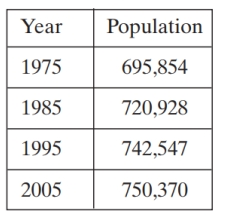
What is the average rate of change in the population with respect to time between 1975 and 2005 ?

What is the average rate of change in the population with respect to time between 1975 and 2005 ?

Unlock Deck
Unlock for access to all 37 flashcards in this deck.
Unlock Deck
k this deck
10
For the function f(x)=4+3 x-2 x2 :
(a) Use the definition of the derivative at a point to find the slope of the tangent line of the function at x=1 .
(b) What is the equation of the tangent line in part a?
(a) Use the definition of the derivative at a point to find the slope of the tangent line of the function at x=1 .
(b) What is the equation of the tangent line in part a?

Unlock Deck
Unlock for access to all 37 flashcards in this deck.
Unlock Deck
k this deck
11
Write the integral that would be used to find the shaded area on the graph shown below.



Unlock Deck
Unlock for access to all 37 flashcards in this deck.
Unlock Deck
k this deck
12
What is the average rate of change of ![What is the average rate of change of over the interval [1.9,2.1] ?](https://d2lvgg3v3hfg70.cloudfront.net/TB34225555/11ec76bb_394e_57a8_9208_bdba5a858983_TB34225555_11.jpg) over the interval [1.9,2.1] ?
over the interval [1.9,2.1] ?
![What is the average rate of change of over the interval [1.9,2.1] ?](https://d2lvgg3v3hfg70.cloudfront.net/TB34225555/11ec76bb_394e_57a8_9208_bdba5a858983_TB34225555_11.jpg) over the interval [1.9,2.1] ?
over the interval [1.9,2.1] ?
Unlock Deck
Unlock for access to all 37 flashcards in this deck.
Unlock Deck
k this deck
13
Use the graph below to find the limits or explain why the limits do not exist.
(a)
(b)
(c)
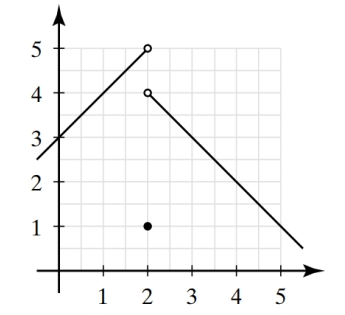
(a)

(b)

(c)



Unlock Deck
Unlock for access to all 37 flashcards in this deck.
Unlock Deck
k this deck
14
Compute the integral  by computing a geometric area. (Hint: Graph the function first.)
by computing a geometric area. (Hint: Graph the function first.)
 by computing a geometric area. (Hint: Graph the function first.)
by computing a geometric area. (Hint: Graph the function first.)
Unlock Deck
Unlock for access to all 37 flashcards in this deck.
Unlock Deck
k this deck
15
Find the derivative of f(x)=7 x+10 .

Unlock Deck
Unlock for access to all 37 flashcards in this deck.
Unlock Deck
k this deck
16
Draw the graph of ![Draw the graph of over the interval [0,4] . On the graph, show and shade the rectangles that would be used to approximate the area under the curve by the right rectangle approximation method using 4 subintervals.](https://d2lvgg3v3hfg70.cloudfront.net/TB34225555/11ec76bc_2e4f_bf5b_9208_e91d7a20e44a_TB34225555_11.jpg) over the interval [0,4] .
over the interval [0,4] .
![Draw the graph of over the interval [0,4] . On the graph, show and shade the rectangles that would be used to approximate the area under the curve by the right rectangle approximation method using 4 subintervals.](https://d2lvgg3v3hfg70.cloudfront.net/TB34225555/11ec76bc_2e51_45fc_9208_e3b867264b95_TB34225555_11.jpg)
On the graph, show and shade the rectangles that would be used to approximate the area under the curve by the right rectangle approximation method using 4 subintervals.
![Draw the graph of over the interval [0,4] . On the graph, show and shade the rectangles that would be used to approximate the area under the curve by the right rectangle approximation method using 4 subintervals.](https://d2lvgg3v3hfg70.cloudfront.net/TB34225555/11ec76bc_2e4f_bf5b_9208_e91d7a20e44a_TB34225555_11.jpg) over the interval [0,4] .
over the interval [0,4] .![Draw the graph of over the interval [0,4] . On the graph, show and shade the rectangles that would be used to approximate the area under the curve by the right rectangle approximation method using 4 subintervals.](https://d2lvgg3v3hfg70.cloudfront.net/TB34225555/11ec76bc_2e51_45fc_9208_e3b867264b95_TB34225555_11.jpg)
On the graph, show and shade the rectangles that would be used to approximate the area under the curve by the right rectangle approximation method using 4 subintervals.

Unlock Deck
Unlock for access to all 37 flashcards in this deck.
Unlock Deck
k this deck
17
Draw the graph of f(x)=-2(x-1)(x-4) over the interval [1,4] . On the graph, show and shade the rectangles that would be used to approximate the area under the curve f(x) over [1,4] by the right rectangle approximation method using 6 subintervals. Compute the estimation.
![Draw the graph of f(x)=-2(x-1)(x-4) over the interval [1,4] . On the graph, show and shade the rectangles that would be used to approximate the area under the curve f(x) over [1,4] by the right rectangle approximation method using 6 subintervals. Compute the estimation.](https://d2lvgg3v3hfg70.cloudfront.net/TB34225555/11ec76c0_158c_f349_9208_234721518f76_TB34225555_11.jpg)
![Draw the graph of f(x)=-2(x-1)(x-4) over the interval [1,4] . On the graph, show and shade the rectangles that would be used to approximate the area under the curve f(x) over [1,4] by the right rectangle approximation method using 6 subintervals. Compute the estimation.](https://d2lvgg3v3hfg70.cloudfront.net/TB34225555/11ec76c0_158c_f349_9208_234721518f76_TB34225555_11.jpg)

Unlock Deck
Unlock for access to all 37 flashcards in this deck.
Unlock Deck
k this deck
18
At what points c in the domain of  exist?
exist?
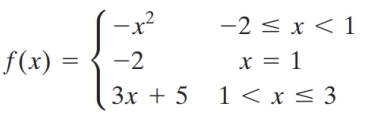
 exist?
exist?

Unlock Deck
Unlock for access to all 37 flashcards in this deck.
Unlock Deck
k this deck
19
Find the average rate of change of f(x)=3 \cos x over the interval 
A) -3
B)
C)
D)

A) -3
B)

C)

D)


Unlock Deck
Unlock for access to all 37 flashcards in this deck.
Unlock Deck
k this deck
20
Partition the interval [1,5] into eight equal subintervals. List the eight subintervals.

Unlock Deck
Unlock for access to all 37 flashcards in this deck.
Unlock Deck
k this deck
21

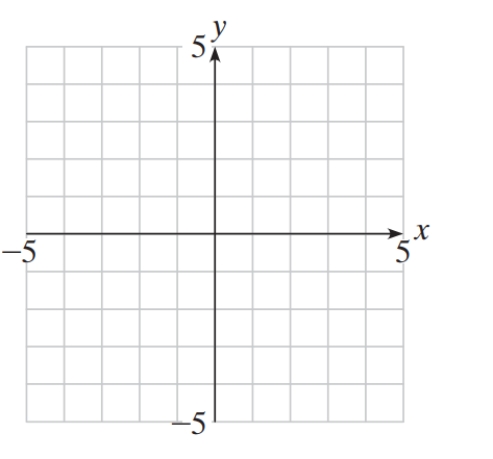

Unlock Deck
Unlock for access to all 37 flashcards in this deck.
Unlock Deck
k this deck
22
Explain how to find the area under the graph of  from x=0 to x=4 by computing the geometric area.
from x=0 to x=4 by computing the geometric area.
 from x=0 to x=4 by computing the geometric area.
from x=0 to x=4 by computing the geometric area.
Unlock Deck
Unlock for access to all 37 flashcards in this deck.
Unlock Deck
k this deck
23
Find the derivative of f(x)=-4 x-8 .

Unlock Deck
Unlock for access to all 37 flashcards in this deck.
Unlock Deck
k this deck
24
Use a calculator to find the RRAM area approximation for the area under the graph  from x=0 to x=2 with 20 approximating rectangles.
from x=0 to x=2 with 20 approximating rectangles.
 from x=0 to x=2 with 20 approximating rectangles.
from x=0 to x=2 with 20 approximating rectangles.
Unlock Deck
Unlock for access to all 37 flashcards in this deck.
Unlock Deck
k this deck
25
Determine 
if the limit exists.
A) -1
B)
C)
D) 1
E) The limit does not exist.

if the limit exists.
A) -1
B)

C)

D) 1
E) The limit does not exist.

Unlock Deck
Unlock for access to all 37 flashcards in this deck.
Unlock Deck
k this deck
26
For the function 
(a) Find the slope of the function at x=2 using the definition of the derivative.
(b) What is the equation of the tangent line to the curve f(x) at x=2 ?

(a) Find the slope of the function at x=2 using the definition of the derivative.
(b) What is the equation of the tangent line to the curve f(x) at x=2 ?

Unlock Deck
Unlock for access to all 37 flashcards in this deck.
Unlock Deck
k this deck
27
Find the instantaneous rate of change of  at x=4 .
at x=4 .
 at x=4 .
at x=4 .
Unlock Deck
Unlock for access to all 37 flashcards in this deck.
Unlock Deck
k this deck
28
Explain how to find the area under the graph of  from x=1 to x=5 by computing the geometric area.
from x=1 to x=5 by computing the geometric area.
 from x=1 to x=5 by computing the geometric area.
from x=1 to x=5 by computing the geometric area.
Unlock Deck
Unlock for access to all 37 flashcards in this deck.
Unlock Deck
k this deck
29
Use a calculator to find the LRAM area approximation for the area under the graph 
from x=0 to x=2 with 20 approximating rectangles.

from x=0 to x=2 with 20 approximating rectangles.

Unlock Deck
Unlock for access to all 37 flashcards in this deck.
Unlock Deck
k this deck
30

(a) Explain why direct substitution cannot be used to find the limit.
(b) Find the limit algebraically, if it exists.

Unlock Deck
Unlock for access to all 37 flashcards in this deck.
Unlock Deck
k this deck
31
Determine the following limits, if they exist.
(a)
(b)
(c)
(d)
(e)
(f)
(a)

(b)

(c)

(d)

(e)

(f)


Unlock Deck
Unlock for access to all 37 flashcards in this deck.
Unlock Deck
k this deck
32
Write the integral that would be used to find the shaded area on the graph shown below.
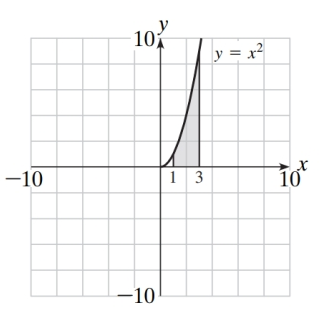


Unlock Deck
Unlock for access to all 37 flashcards in this deck.
Unlock Deck
k this deck
33
At what points c in the domain of f(x) does  exist?
exist?

 exist?
exist?

Unlock Deck
Unlock for access to all 37 flashcards in this deck.
Unlock Deck
k this deck
34
Find the average rate of change of f(x)=5 \tan x over the interval 
A)
B)
C) -10
D) 0

A)

B)

C) -10
D) 0

Unlock Deck
Unlock for access to all 37 flashcards in this deck.
Unlock Deck
k this deck
35
Use the graph below to find the limits or explain why the limits do not exist.
(a)
(b)
(c)
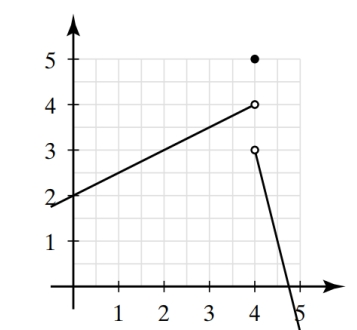
(a)

(b)

(c)



Unlock Deck
Unlock for access to all 37 flashcards in this deck.
Unlock Deck
k this deck
36
A baseball is dropped from a window. Find the baseball's (a) average speed during the first 2 sec of fall and (b) instantaneous speed at t=2 .

Unlock Deck
Unlock for access to all 37 flashcards in this deck.
Unlock Deck
k this deck
37
The following table lists the population statistics for a certain city.
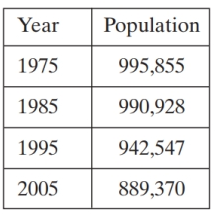
What is the average rate of change in the population with respect to time between 1975 and 2005 ?

What is the average rate of change in the population with respect to time between 1975 and 2005 ?

Unlock Deck
Unlock for access to all 37 flashcards in this deck.
Unlock Deck
k this deck



